Each interior should have a zest. Sometimes it's an antique figurine on a dresser, a minimalist painting on the wall, or an exclusive lamp on a high stand. Designers usually charge a lot of money for handmade decor. But why spend money if you can design a floor lamp yourself beautifully. Do you agree?
And how to do this and what is needed for work - we will tell you in detail in this article. Let's talk about how to make a lampshade out of scrap materials with your own hands. We will share interesting photos with lighting design ideas. We will help you choose inexpensive and safe materials for your hand-made floor lamp or lamp.
The content of the article:
- Floor lamp style and material combination
- Rules for creating safe homemade products
-
The choice of design and assembly of the lampshade
- Making frameless lampshades
- Ideas for making frame lampshades
-
Making a frame for a lampshade
- Option # 1 - trash can
- Option # 2 - metal mesh
- Option # 3 - grill from an old fan
- Instructions for making a fabric lampshade
- Conclusions and useful video on the topic
Floor lamp style and material combination
A lampshade can be made from a wide variety of materials. Surprisingly, some craftsmen beautifully decorate their lighting fixtures using old and unnecessary things: newspapers, colored wrappers and even egg boxes.
In its design, the floor lamp should be combined with the general interior of the room. Let's take a closer look at what materials are suitable for each direction in design.
Styles and materials:
- Country - wood, metal or a combination of these materials.
- Classic - various natural fabrics, as well as paper.
- Provence - fabrics decorated with ribbons or embroidery.
- Ecostyle - tree branches, seashells and other natural materials.
- High tech, Art Deco - a combination of glass and metal parts, stone.
For Tiffany, Chinese and Japanese stylistics is characterized by minimalism. It should also be visible in decorative elements. To decorate the lampshade of a floor lamp, you can choose wooden elements, rattan or fabrics with patterns of oriental themes.

It is easy to create an original wine cork lampshade. To do this, you need glue (more convenient with a glue gun), an old lampshade and bottle caps from wine or champagne
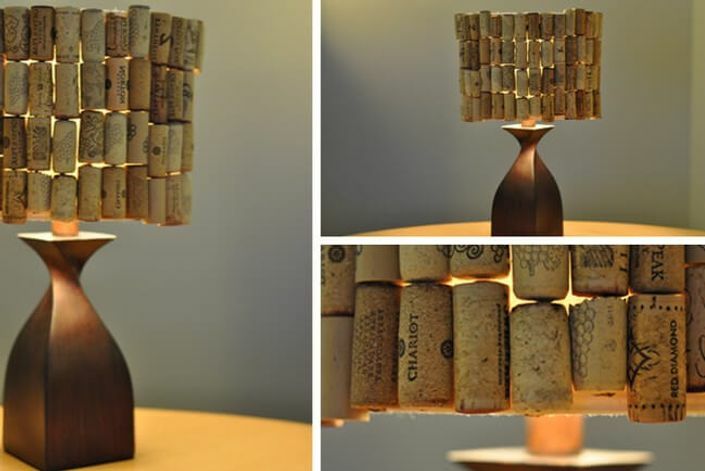
A ready-made wine cork lampshade is suitable for decorating a floor lamp or table lamp. It fits perfectly into a loft-style interior, as well as into rooms with wood trim and other natural materials.
Regardless of the style chosen, creating a homemade lampshade should be taking into account safety rules. During operation, the lighting device will generate heat, therefore there must be a distance between the lamp and the material, otherwise a fire may occur.
Rules for creating safe homemade products
Any factory that produces floor lamps has technologists on staff. When creating a new model of a lighting device, such specialists calculate the permissible distance from the lamp shade material to the light bulb. In this case, the degree of heat resistance of the constituent components of the product, the power of the lamps, and other factors must be taken into account.
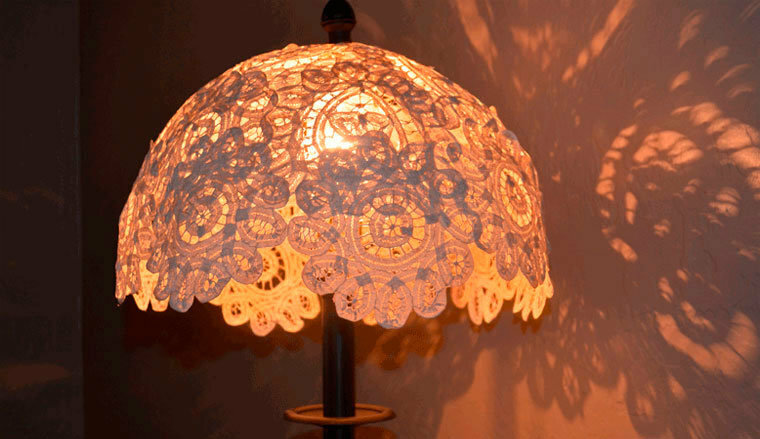
It is better to screw fluorescent or LED types of bulbs into a homemade floor lamp. They do not heat up much and do not consume a lot of electricity.
Lampshades made of fabric, paper or other flammable material must not be operated together with incandescent lamps. Because they get very hot and can cause the lampshade to catch fire. We talked more about the types of bulbs in this article.
If the choice fell on LED and fluorescent lamps, you need to pay attention to their plinth. It must be of high quality. Options made of metal or ceramic are optimal. These bulbs are more expensive than conventional bulbs, but they have many advantages: long life operation, practically do not heat up, do not consume a lot of electricity, produce a more even flow of light and do not flicker.
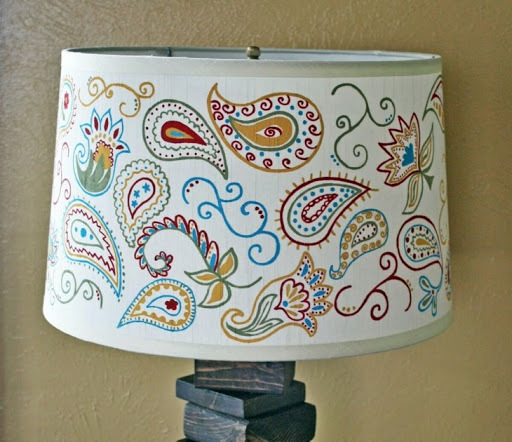
A lampshade made of paper, cotton or synthetic fabric, cardboard, woolen threads and other flammable materials should be at least 50-70 mm away from the lamp
When the lampshade for the floor lamp is completely ready and the whole structure is assembled, you need to turn on the lamp and watch it work for a while to check if the walls are heating up. If the material feels hot to the touch, change the light bulb to a less powerful version.
Homemade lamps can be used in the bedroom, hallway or living room. They are not used in rooms with high humidity, as there is a risk of a short circuit.
By adhering to these rules, you can create a beautiful and safe floor or table lamp that will last a long time.
The choice of design and assembly of the lampshade
Structurally, lampshades can be divided into frame and frameless. The first option is more reliable and durable. Many types of materials are easier to shape when there are additional stiffeners.

An example of a frame lampshade. The bead braid is fixed on a rigid metal frame, which gives the structure the correct shape and does not allow the material to slip
The shape of the frame can be any - the choice depends on the style of the room and the imagination of the master. The main thing is that the distance between the lamp and the lampshade finish is maintained.
Frameless variations have an original appearance and lighter weight. However, this model is not suitable for all materials.
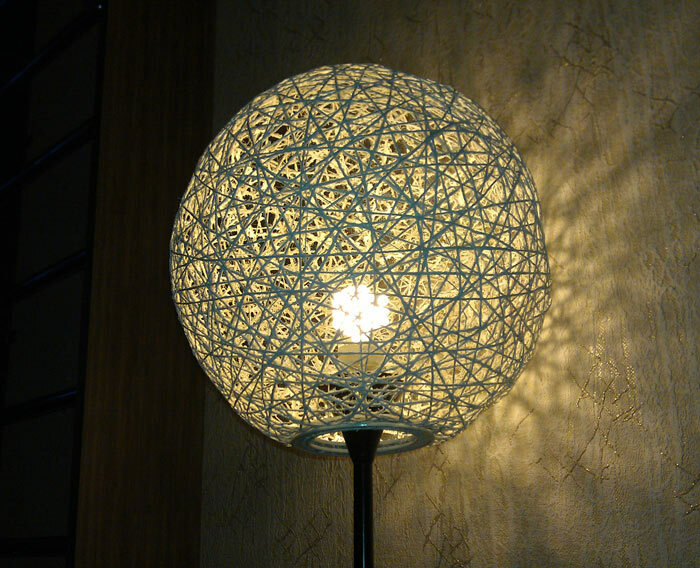
An example of a frameless lampshade. For its manufacture, an inflatable ball was used, on which threads treated with glue were fixed. When the glue has dried and the material has acquired the desired shape, the base was removed
At the initial stage of manufacturing a frameless lampshade, you need to choose the right place for the location of the light bulb. So that during the assembly of the structure, there is a distance between the homemade shade and the lamp. The service life of such products is much shorter than that of frame ones.
Making frameless lampshades
Before creating a frameless lampshade, you need to prepare a template. It can be an inflatable ball or a balloon that you will not mind piercing. Knitted napkins, clothesline, yarn or threads can be used as upholstery material.
Algorithm of work:
- The ball or ball must be well inflated and fixed in one position. To do this, you can use a bowl that is suitable in diameter.
- Saturate the material for the lampshade with PVA glue.
- Place the material on the ball. Be sure to leave a hole under cartridge (it is better to frame the hole with a plastic ring).
- When the glue is completely dry, punch and pull the ball. The shape of the lampshade will remain the same.
In the left hole, you need to carefully insert the lamp holder and attach the lampshade to the rod. The rod can be used from an old floor lamp or made yourself from various materials: wooden cuttings, a tripod, metal rods, etc.
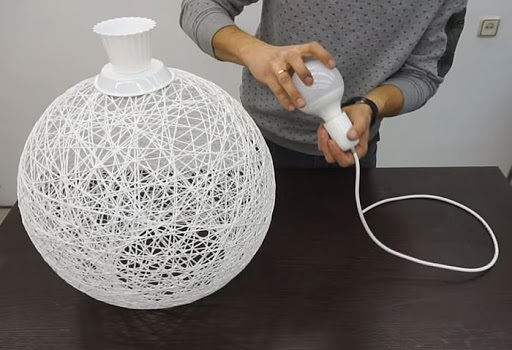
The finished lampshade has good rigidity, but in case of accidental mechanical damage, it can crumple. Therefore, the cartridge must be installed as carefully as possible so as not to damage the structure.
The color of the finished shade can be changed with spray paint. Although you can do without dyeing - threads and twine in natural color also look good.
Ideas for making frame lampshades
If there is an old frame from a floor lamp, then this is already half of the work done. You just need to choose the style of the lighting fixture and update the design. For these purposes, you can use a variety of fabrics and materials.
Successful options for materials for sheathing lampshades:
- Textile - give preference to natural types. Synthetic options fade quickly and can melt from heat.
- Rope - well suited for fitting frame options for lampshades. It is possible to choose the thickness of the string.
- Yarn - applicable for classic floor lamps. Usually yarns with a thread thickness of 1-5 mm are used.
- Ribbons - can be used to decorate the finished shade, as well as for weaving on the frame. They have a wide range of colors.
- Wooden elements - for the manufacture of lampshades, various slats, branches and perforated boards are used.
- Paper and cardboard - allow you to make decorative parts for decorating lighting fixtures. This is one of the cheapest design options. Such a lampshade can be changed at least every month.
Even the most unexpected elements can be used to create a lampshade, for example, watch gears, buttons, kitchen graters, metal cans and other materials at hand.
In the gallery below you can see a selection of interesting design ideas:
Image gallery
Photo from
Linen and cotton are ideal for covering the frame of the lampshade. So that the material attracts less dust and does not fade in the sun, it is better to buy fabric with a special water-repellent impregnation
You can sheathe the frame of a floor lamp using thin branches. Wooden palisade lampshade suitable for lovers of natural materials
To create a floor lamp, it is advisable to use ropes from natural materials. Such lighting fixtures fit well into the loft and eco-style.
It is not necessary to use only plain paper to decorate the lampshade. Lamps decorated with old newspapers, a world map, blueprints or old manuscripts turn out to be quite creative. You can use the origami technique, as well as decoupage
If you decorate the lampshade with light buttons, we get an original classic-style floor lamp. For less restrained interiors, you can use floor lamps decorated with multi-colored buttons.
Almost any lamp or floor lamp can be decorated with artificial flowers. These can be separate elements of the lampshade decor or solid design.
Floor lamps with photo printing look creative. You can print your favorite characters or even your own photos on paper. The finished material must be carefully glued to the frame so as not to damage the image
Spoons and other disposable tableware can be used to create a lampshade. Easy to make decoration from plastic bottles. This version of a floor lamp is ideal for giving
Fabric frame lampshade
Wooden lampshade in eco-style
Decorating with twine
Lampshade made of paper
Use in the design of buttons
Artificial flowers lampshade
Using photo printing for decoration
Lampshade made of plastic elements
The above design options are suitable for updating old floor lamps, which have preserved the frame. If the metal base has collapsed, you will need to make it yourself.
Making a frame for a lampshade
The frame can be made of steel wire with a diameter of 3 mm or more. The joints of the structure are welded by means of spot welding.
But this method is laborious, and the welding machine is not always at hand.
Have you decided to use welding but don't know how to use the machine? We recommend that you familiarize yourself with nuances of welding seams.
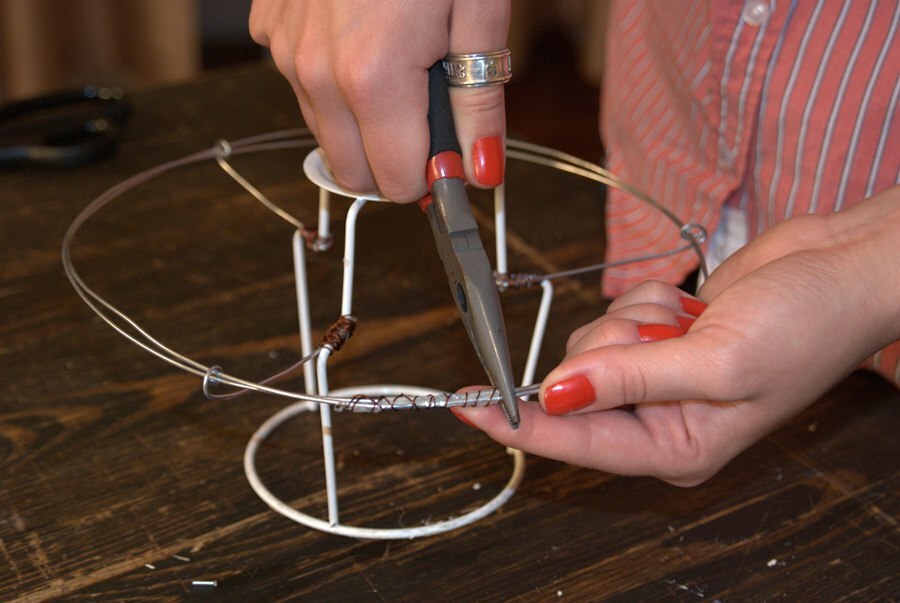
Some craftsmen in the frame combine thick steel and thin copper wire, connecting them together by twisting
A frame twisted from several types of wire, no matter how hard you try, it will not have an ideal shape. It, of course, can be decorated in a loft style and use a floor lamp only in the country. However, such a lampshade will not work for a cozy home living room.
It is easier to work with aluminum wire, it is soft and easy to deform. With its help, you can "twist" the frame of almost any shape. But the lampshade will not have good rigidity. If dropped or otherwise accidentally damaged, it will lose its shape.
If it is not possible to buy a ready-made metal frame for a lampshade, you need to look for alternative options - materials and products that are inexpensive or are at home.
Option # 1 - trash can
It is easy to make a frame from a metal waste basket. If the size of the product and the shape are suitable, you can proceed with the design.

Using nippers in the bottom, you need to make a hole for the cartridge. A circle of small diameter is immediately cut out, if necessary, it is increased
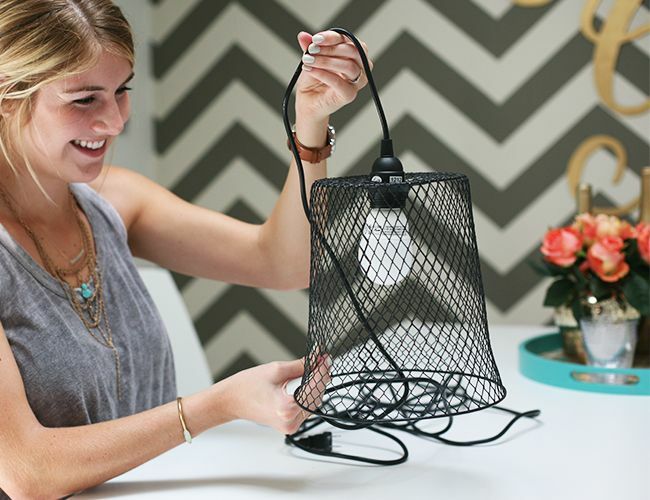
After a hole has been made in the bottom part, a cartridge is inserted from the inside of the basket. It should sit well and not slip out
The base of the lampshade should be decorated based on the overall style of the interior.
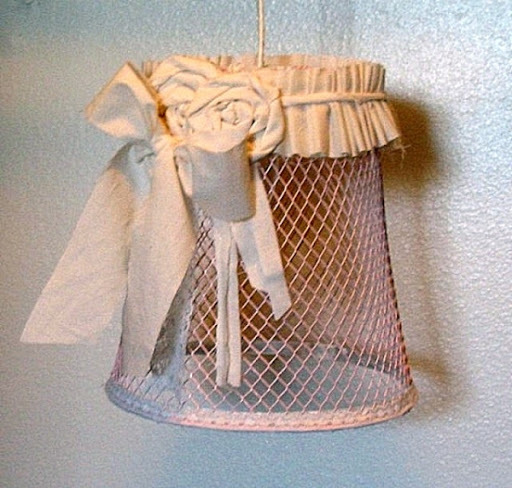
The basket lamp shade can be completely covered with fabric to hide the frame. The partial decoration of the product with ribbons also looks interesting. The mesh surface is painted with paint in the desired color
The floor lamp from the basket can be decorated with colorful cable ties, leather cords and other materials.
Option # 2 - metal mesh
You can buy a mesh at a hardware store. The product is produced in several size variations, differing in the size of the cage.
For a floor lamp, it is most convenient to use the version with cells of 20 × 20 or 15 × 15 mm.
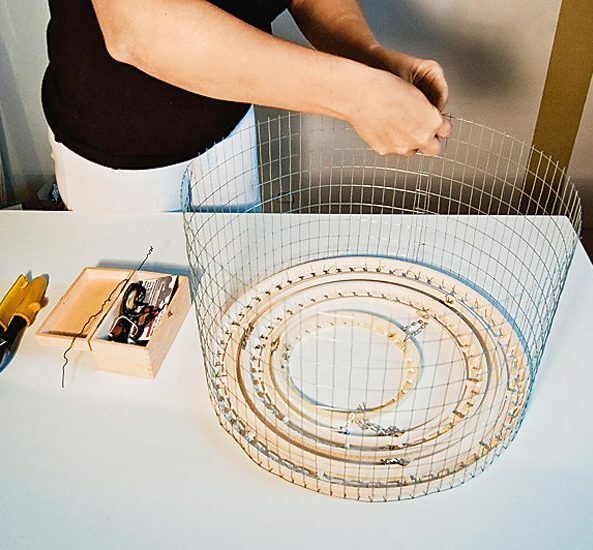
It is easy to make a frame for a lampshade from a mesh. You just need to connect the edges of the fragment. To do this, they are laid with an overlap and twisted with wire.
The metal mesh is suitable for creating a frame in the form of a cylinder. You can twist a truncated cone out of it. It is problematic to create other forms.
Option # 3 - grill from an old fan
The fan grille is the perfect frame for your lampshade. It already has the desired spherical shape. If desired, the design can be made deeper. To do this, an additional tier is tied on the bottom of the lattice.
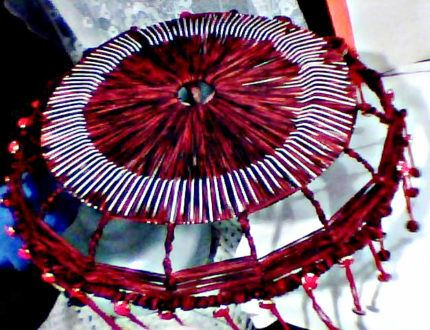
Fan louver shade can be decorated with thread fringes and beautiful buttons. Metal parts are braided with woolen threads or embroidery threads, the edges are released and buttons are fixed on them
Before you start decorating the lampshade, you need to put the old grille in order. If there are traces of corrosion, sand the metal with sandpaper and only then can paint be applied.
Instructions for making a fabric lampshade
First of all, you need to prepare the material and tools. The easiest way is to make your own lampshade for a cone-shaped as well as a cylindrical frame.
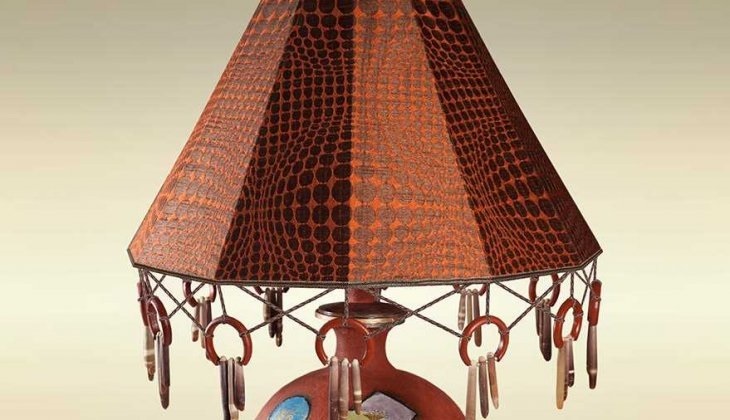
The material must be selected taking into account the frame. If it is homemade and made of ordinary wire, then it is better to use a dense opaque fabric to hide possible defects.
The wire frame must be painted and dried. Its rods are wrapped with a cotton ribbon and only then covered with a cloth. It is advisable to sew the lampshade on a sewing machine, so it will look neater.
In addition to fabric, you will need:
- kraft paper (can be replaced with Whatman paper);
- fabric glue;
- pins and threads;
- simple pencil;
- ruler;
- iron.
First, make a pattern. It will help you cut the required amount of material.
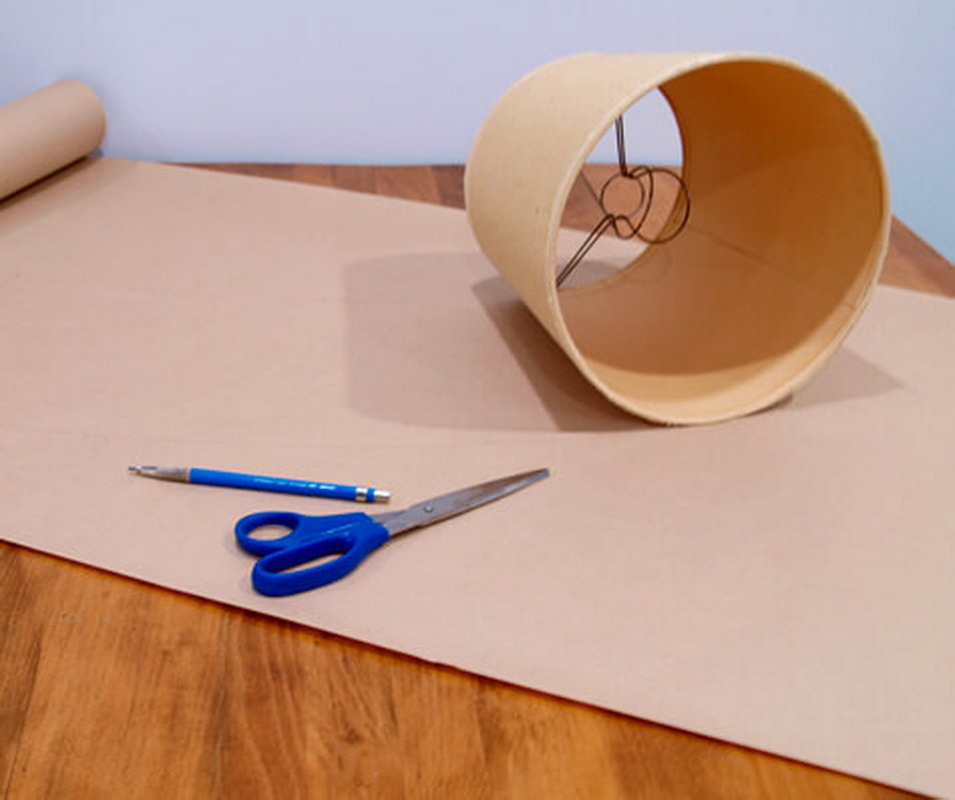
To make a lampshade template for a cone-shaped frame, you need to turn it on paper and mark the lines of the sides with a pencil.
To make a pattern of a cylindrical frame, first measure the circumference and draw one line, and then measure the height and draw a second line. Next, two more sides are daughter and a rectangular template is cut out.
It is best to double-check the dimensions of the template before cutting the fabric. To do this, a rough pattern is applied to the frame, if it is larger, the excess paper is cut off.
The material can be attached to the correct template. The pattern should be applied from the inside of the fabric. Fix its position with pins.
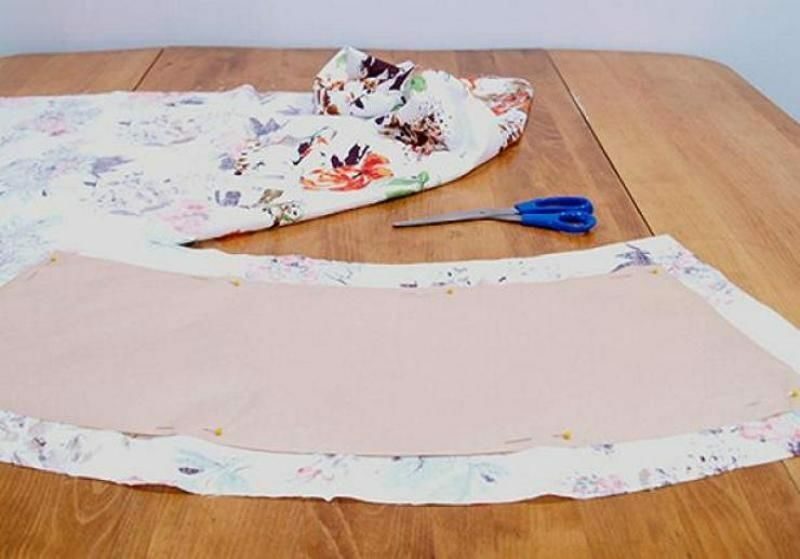
It is important to correctly position the template on the material. Especially if the fabric is patterned or patterned. After all, you can “cut off” the flower head, but it will look ugly
The template is outlined along the contour with a pencil (chalk for dark fabrics). After that, allowances are drawn - 1.5-2 cm from the border of the pattern. These allowances are then folded inward, and the fold lines are fixed with pins and the kraft paper is removed.
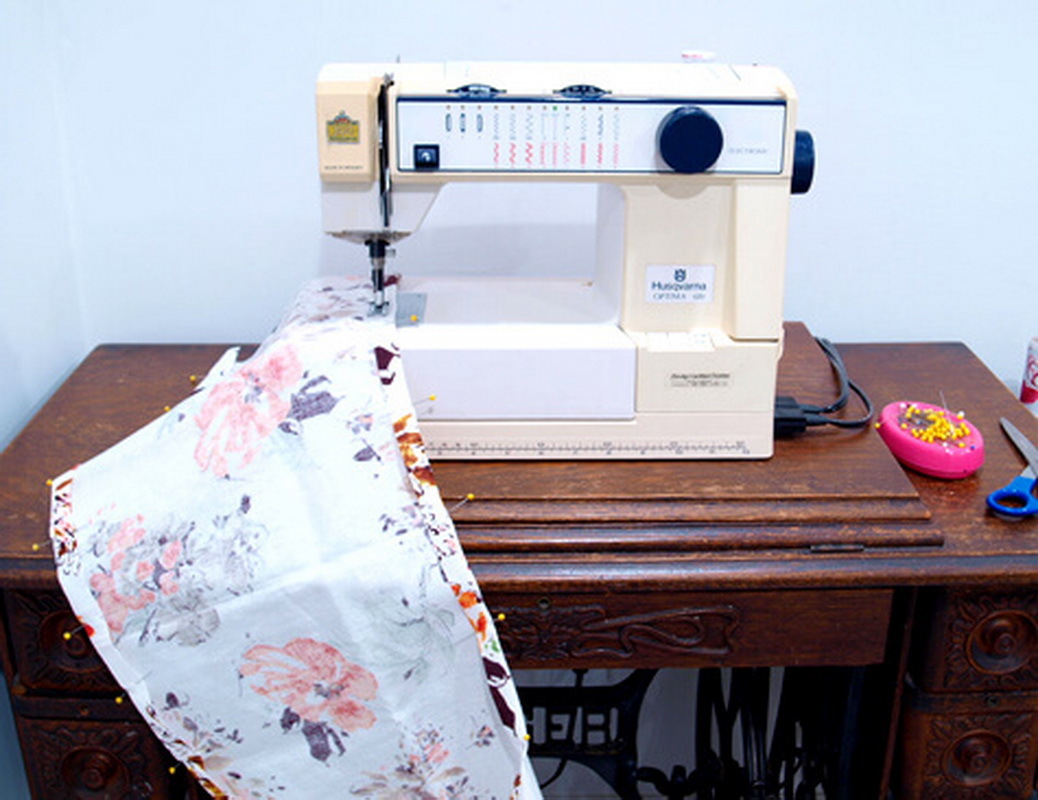
Only three sides of the part are grinded on a machine. The raw side is left so that a neat seam can be formed on the shade frame.
The finished workpiece must be smoothed with a hot iron. The fabric must be perfectly flat, otherwise it will not adhere normally to the base.
Next, glue is applied to the fabric and glued to the frame. Be sure to hide the raw slices. If the fabric blank is attached to a metal base wrapped in ribbons, then only those areas that are in contact with the frame are treated with glue.
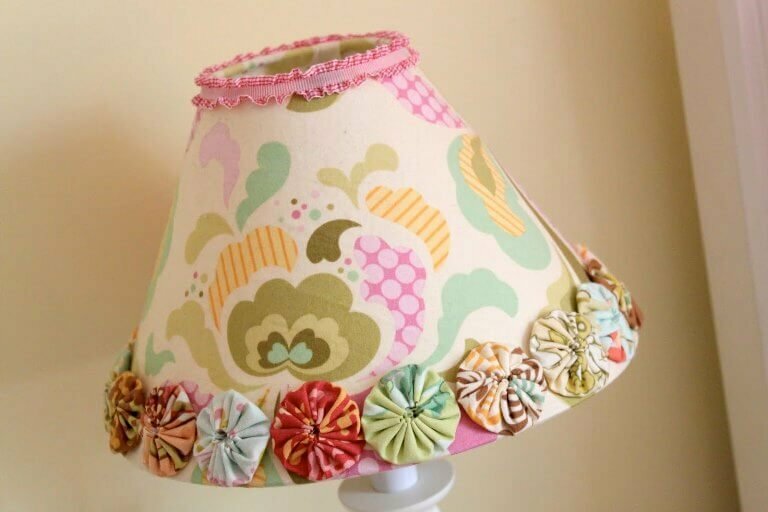
You should not immediately put on the updated lampshade on the floor lamp. You need to leave it for 1-2 days so that the glue dries well.
The fabric lampshade is ready. Along the edges it can also be decorated with additional decorative elements - flowers, bows, butterflies.
Conclusions and useful video on the topic
You can see the step-by-step instructions for creating a lampshade with your own hands in the video below:
To make a lampshade with your own hands, you do not need special skills and large cash costs. It is interesting to design a floor lamp from scrap materials, for example, cotton fabric, bottle caps or paper.
The easiest way to update an old floor lamp with a frame is to glue it on top with bright material. Although it is not difficult to choose an alternative base for the lamp. This could be a metal waste basket, an old fan grill, or a construction mesh.
Do you like making interesting and useful homemade products from scrap materials? Or have you recently updated your floor lamp shade and want to show the result of your efforts to other users? Add original photos, share interesting ideas in the comment section below the article.


